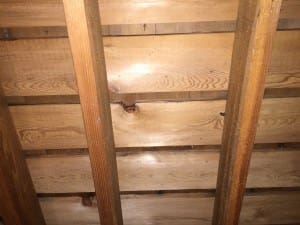Cedar roofs were once the norm prior to the manufacturing of asphalt shingles. In older parts of the City of Milwaukee we find a lot of cedar hiding under layers of asphalt shingles. There’s really only one way to verify with any degree of certainty whether your roof has cedar shingles.

The only way to be sure to know whether a house has had a cedar roof is to look in the attic. Looking at a gable end can be helpful, but it’s no guarantee that you’ll catch whether the roof has cedar or not.
Look in the attic.
With homes that used to rely on cedar shingles, ventilation was always key to making sure that the cedar lasted a long time. For that reason, decking boards were often placed anywhere from a half inch to two inches apart, allowing air to dry out the underside of a cedar roof.
If you see those gaps, look between them. Do you see vertical pieces of cedar shingles? Chances are safe then that you have a cedar roof.
Challenges with replacing a cedar roof
Most homes that have relied on cedar roofing at one time or another in the past, have had asphalt shingles nailed right on top of them. No, this isn’t the proper way to install roofing, but it certainly is common in some older, especially working class, neighborhoods.
Redecking is the only option
If you have 1″ or greater gaps in the decking of your roof, you must have your roof redecked. The most common way is to lay 7/16 OSB or plywood right over the existing gapped decking. This assure that when you go to nail a shingle in, the nail will have a place to “bite”. This is what holds the shingles onto your roof.
When replacing decking, gutters must be replaced
Homeowners usually don’t want to hear this, especially when they believe their gutters are functioning perfectly fine. Why must they be replaced they ask — it’s about the basic mechanics of flashing. There is a piece of flashing that goes underneath the first layer of shingles and hangs into the gutter. This is called gutter flashing, or gutter apron. If your new decking is on top of the protective gutter flashing, in the winter when water freezes (this applies to northern climates primarily), it will back up on top of the gutter and saturate the new OSB board that your roofer installed so he had a nail base. If it saturates OSB and then we get a freeze, it will start to rot that OSB and the new decking that you had installed will be compromised. Compromised decking and improper flashing means you’ll be getting water in the house and you’ll have to replace the roof.
Can’t you just put a new gutter apron on?
Well you can, but then you’re going to be re-piercing the back of the gutter (with screws or nails depending on what you have now) and your fascia will rot out. Add to that, the problem that will occur is that when gutter brackets are re-attached, your gutter will likely be out of pitch.

